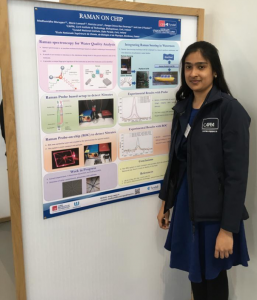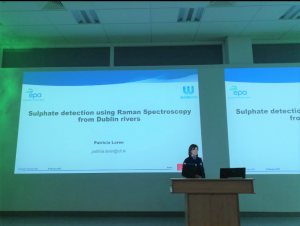CAPPA was delighted to attend this year’s 29th Irish Environmental Researchers Colloquium (ENIVRON) conference which took place in the Institute of Technology Carlow from 15th – 17th of April 2019. Dr Patricia Loren and PhD student Madhumidha Murugan represented CAPPA at the conference speaking about their work as part of the WaterMon project. Environ is the longest running and largest forum for environmental researchers in Ireland with an average of 300 delegates attending the event each year. It provides a high-visibility platform for researchers to present their findings to an audience made up of academia, government bodies, agencies and industry. The main theme for Environ this year was engagement for climate action. Environ 2019 focused on a number of key themes including: water quality and resources, waste management, energy, climate change, invasive species, environmental policy and communication human health, ecotoxicology, environmental management, air quality and urban development, marine and coastal, sustainable transport, the human built environment, sustainable infrastructure, sustainable land use and agriculture, biodiversity and ecosystems, nanotechnology and the environment, smart technology and the environment, sustainable crop science and nature – based solutions for resilient communities.
Dr Patricia Loren spoke on the second day of the conference on Sulphate detection using Raman spectroscopy from Dublin rivers which she is currently working on as part of the WaterMon project. Achieving and maintaining high water quality standards is an important topic worldwide. Although surface water is being permanently monitored in most parts of the European Union, there is a great concern about increasing water pollution. Beyond normal human activities, the release of ionic nutrients and agrochemicals from intensive agricultural and animal waste accelerates eutrophication of freshwater and coastal marine ecosystems. Sulphates, for example, occur naturally in drinking water. However, health concerns regarding sulphates in drinking water have been raised due to reports indicating that diarrhea may be associated with the ingestion of water containing high levels of sulphates. Within this context, Raman spectroscopy is seen as a very powerful technique which provides detection of chemical and biological contaminants in a water environment. With Raman spectroscopy, it is possible to identify different substances since, a Raman spectrum consists of many Raman lines and each line can be associated with a particular chemical structure or bond. River water from 20 different regions in Dublin was analyzed using Raman spectroscopy consisting of a compact probe which allows to connect a laser (MOPA/ 785nm @300mW) via optical fibre and collect the scattering with another optical fibre which will be connected to a spectrometer (Wasatch Raman 785nm, resolution 10 μm slit 4 cm-1), with intergration time set to 2.5s and 25 averages. In 5 samples peaks corresponding to sulphates (980 cm – 1) were found. The same samples were sent to a laboratory or identification and quantitative analysis, proving the presence of high levels of sulphates in the 5 identified by the Raman method. The highest sulphate levels observed to date were around 2622 mg/L, which is considered to be detrimental to public health in river water.
The WaterMon project aims to develop and demonstrate a real-time monitoring technology for the detection and monitoring of pathogens, E-Coli and Enterococci, and Nitrogen and Phosphorus (N&P), in drinking and bathing water. This is a two-year project which has received funding from the Environmental Protection Agency of Ireland (EPA). You can learn more about the WaterMon project here and you can keep up to date with all the latest news and events from CAPPA here.





